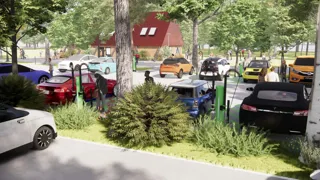Fleets that have a towing need may need to look at new business models to adopt electric vehicles (EVs), new research suggests.
Arval UK has revealed towing will reduce an electric EV’s range by 23-31% against the real-world figure.
Alongside the towing data, the Arval study also provides up-to-date insight into the impact of payload on electric light commercial vehicles (LCVs).
For mid-size electric vans, a half load resulted in a dip of 7% against the real-world range and an 11% dip with a full load.
However, add in towing and the range was 24% lower than the unladen real-world maximum.
These drops, say Arval, represent a 14% drop between fully loaded and fully loaded plus towing.
For large electric vans, the half-load figure recorded was an 11% drop, for a full load 14% and when towing the range was 31% lower than the real-world maximum.
Moving from full loaded to fully loaded plus towing equates to a 20% drop in range.
In Arval UK’s testing, the car saw a 23% fall in electric range when towing.
By comparison, for diesel vans, Arval's experts use a degradation in fuel efficiency of 15% when towing, against a van that's at 100% payload.
Report contributor and Arval UK’s LCV consultant, Simon Cook, explained: “For commercial vehicles, which typically tow while also carrying a full load, the research found range was reduced by between a quarter and a third over the real-use figure.
“What does this mean in reality? If your fully-charged van range is typically 120 miles unladen, then you're looking at a 83-91 mile maximum while towing.
“If you're already operating on the basis of a range while at 100% payload and a range of 105 miles, then the impact of towing will be a 14-22 mile decrease.”
With the Government’s initial target for new electric vehicles sales set at 22% for cars and vans in 2024, knowing which roles electric vans are suitable for is vital.
While company cars are incentivised through attractive benefit-in-kind (BIK) rates, electric company vans have relatively little Government support.
Cook added: “Electric vehicles are very good for the act of towing – their smooth and instant power delivery really helps.
“However, the range and charging infrastructure mean electric vans won’t work for all businesses’ needs at this point in time.
“Solving the BEV adoption hurdles in the wider LCV market may need some significant work, but in all but a couple of areas progress is being made.
“Van ranges in the small and medium sectors are improving rapidly. Charging infrastructure is seeing significant investment. There are however still difficulties surrounding larger eLCVs that cover higher mileages.”
The Arval research was discussed at a recent Fleet News webinar held in partnership with the leasing company (see below).
The Transitioning to Electric Vans webinar in partnership with Arval examined how fleet decision-makers face a different set of challenges when transitioning their vans from diesel or petrol to electric compared to switching company cars to electric.
Topics covered included how to choose the right models, the impact of payload and towing on electric vans, charging infrastructure for electric vans, and residual values and the used electric van market.
Fleets feel ‘misled’ over range
Arval’s report comes in the wake of concern around the real-world range of electric vans highlighted by the Association of Fleet Professionals (AFP).
The trade body has said that fleets feel misled over the claimed range of electric vans after finding that they are falling short of official figures by up to 50%.
AFP chair Paul Hollick said: “We now have a number of fleets who have operated electric vans for a reasonable period of time and crucially, through the recent winter.
“The differences in range that are being reported on some models are, we believe, a cause for concern.
“The weather factor is especially proving to be much greater than originally thought, with some of our members seeing a drop in range approaching 50% during the coldest winter days on occasions when there was no opportunity to precondition the battery.
“These are not the relatively minor variations in range that might be reasonably expected.”
However, other issues are emerging too, according to Hollick. “Payload was already known to have a negative impact – although its extent has proven to be a surprise to some operators – but the effect of commonly-used fittings such as roof racks and ladder loaders are proving noticeable,” he explained.
The issue is making these vehicles sometimes difficult to use in real world conditions, with fleets being unsure on some days in winter whether they could complete the routes on which they were normally used.
> Interested in comparing electric vehicle data? Check out our EV tool.
> Interested in ensuring the efficient use of EVs. Check out our dedicated editorial sections: Insight & policy | EV news | Charging & infrastructure | Costs & incentives | Benefit-in-kind | EV case studies | EV road tests






















Login to comment
Comments
No comments have been made yet.